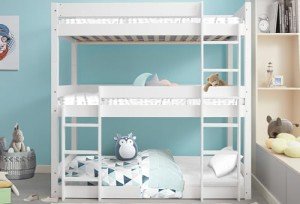The Ultimate Guide to Bunk Beds for Kids: Safety, Styles, and Solutions
Bunk beds have long been a popular option among parents seeking to enhance space in their children's bed rooms. With advantages that exceed their compact style, bunk beds offer a fun and practical sleeping arrangement while encouraging brother or sister bonding and promoting creativity. In this thorough guide, we check out different aspects of bunk beds for kids, consisting of security considerations, different styles offered, and suggestions for selecting the ideal one for your household.
Why Choose Bunk Beds?
Bunk beds are designed to stack one bed on top of another, using vertical space to develop more space for play and storage. They are particularly useful for families with multiple children or restricted bed room space. Furthermore, they offer a daring sleeping environment that children frequently delight in.
Key Advantages of Bunk Beds:
- Space-saving style: Ideal for little spaces or shared spaces.
- Affordable: Often more cost effective than buying 2 separate beds.
- Encourages social interaction: Promotes bonding amongst siblings or pals.
- Versatile alternatives: Available in different styles and configurations to match any space design.
Safety First: Essential Considerations
When choosing a bunk bed for kids, safety needs to be the leading priority. The following functions are vital for guaranteeing a safe sleeping environment:
Important Safety Features:
- Sturdy Construction: Ensure that the bed frame is made from long lasting products such as strong wood or metal.
- Guardrails: Bunk beds should have guardrails on both sides of the upper bunk to prevent falls.
- Ladder Safety: A durable, built-in ladder or stairs with anti-slip rungs is important for safe access to the top bunk.
- Weight Limit: Check the manufacturer's weight limitation capability for both the top and bottom bunk.
- Mattress Size: Use the right bed mattress size as defined by the bed manufacturer to make sure a tight fit within the bed frame.
Safety Tips for Parents:
- Monitor Sleep Habits: Teach children the value of not using or jumping off the bunk beds.
- Age Appropriateness: Generally, the upper bunk appropriates for children aged 6 and older.
- Routine Inspections: Periodically look for any loose bolts, screws, or structural damage.
Styles of Bunk Beds
Bunk beds can be found in a variety of designs, allowing parents to select one that complements their child's room decoration while conference specific needs. Below are some popular designs:
Popular Bunk Bed Styles:
- Traditional Bunk Beds: Simple and classic styles made from wood or metal without any extra features.
- Loft Beds: Features a raised top bunk with space underneath for a desk, play location, or extra storage.
- L-Shaped Bunk Beds: Arranged in an L-shape, frequently perfect for corner spaces and can have additional storage options.
- Twin over Full Bunk Beds: A twin bed on the top and a bigger full-sized bed on the bottom, accommodating kids or teens of various ages.
- Triple Bunk Beds: Designed to fit three beds in a single footprint, perfect for larger families or sleepovers.
A Comparison of Bunk Bed Styles
| Bunk Bed Style | Description | Best For |
|---|---|---|
| Standard | Timeless design with 2 stacked beds | Standard bedroom setups |
| Loft Bed | Raised bed with usable space underneath | Research or play locations |
| L-Shaped | Bunk beds arranged in an L-shape | Corner spaces |
| Twin over Full | Twin bed on top, full bed below | Different age brother or sisters |
| Triple Bunk | Three stacked beds | Big households or sleepovers |
Choosing the Right Bunk Bed
When searching for the ideal bunk bed, think about the following aspects to ensure you make an informed choice:
Key Factors to Consider:
- Room Size: Measure the space measurements to figure out the appropriate size and height of the bunk bed.
- Child's Age: Consider the age of your kid(ren) when selecting a style and security features.
- Functionality: Think about just how much storage or play space you require and whether the bunk bed need to serve extra purposes.
- Budget: Set a budget plan that consists of not just the bunk bed however also the required mattress and devices like bed linen or safety gates.
FAQs About Bunk Beds for Kids
1. What age is proper for a child to sleep in the top bunk?
Generally, kids aged 6 and older should have the ability to safely oversleep the leading bunk, though you need to constantly consider your kid's maturity level.
2. Are bunk beds safe for young children?
It is not recommended for toddlers or very young children to oversleep the top bunk due to the risk of falling.
3. How do I preserve the bunk bed?
Examine the bed regularly for any indications of wear and tear, tightening screws, and cleaning the bed mattress to ensure extended safety and sturdiness.
4. Can I transform a bunk bed into two different beds?
Lots of bunk beds are created to be convertible, permitting you to separate the beds when needed. www.bunkbedsstore.top before acquiring.
5. How can I make the most of space in a bunk bed room?
Utilize under-bed drawers, shelves, or lofted styles to develop additional storage options in a room with a bunk bed.
Bunk beds provide a wonderful mix of fun, performance, and space-saving energy, making them a perfect choice for young households. By considering safety functions, numerous designs, and useful aspects such as room size and age appropriateness, moms and dads can select the ideal bunk bed for their kid's needs. With the best option, bunk beds can change a bed room into a magical space that encourages play, imagination, and bonding among brother or sisters. Always keep in mind to focus on security and maintenance to make the many of this special sleeping arrangement.

